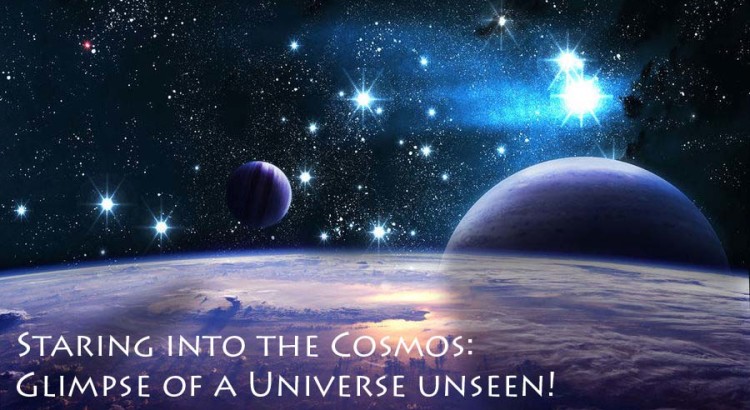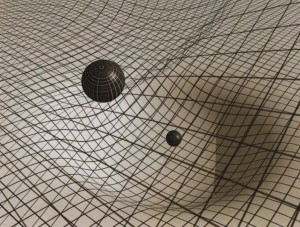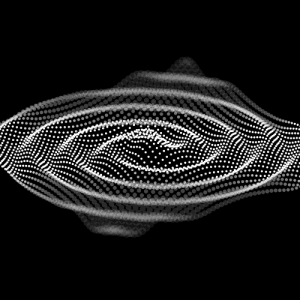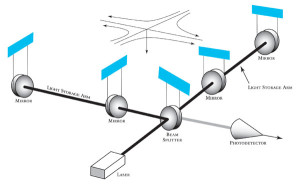Mankind is celebrating another milestone in its struggles to understand the nature of the Cosmos around us. Laser Interferometer Gravitational-Wave Observatory (LIGO) recently announced that they have, for the first time, seen signs of gravitational waves passing through their detector. But what are these things they call gravitational wave? Before talking about that, we need to look into the meaning of space-time and information.
Another direct consequence of Einstein’s idea is that “information” can at most propagate with the speed of light in vacuum (about 299 792 km/s). This means when you look at some object around you, you are basically looking at its state at the time light took off from that object but during the time light took to travel to your eye, it could have changed. This is an astounding result! So all information that we receive reaches us with a finite amount of delay, no matter how small that delay may be. So the use of the word ‘real time’ is greatly over rated; nothing in this Universe is truly real time!
Very soon after it became apparent to Einstein that gravitational influences must also travel with a certain delay. This concept did not exist before Einstein. Gravitational influence of one region, on some other region, encodes the information of the distribution of matter in that area. Before Einstein’s achievement of Special Relativity, it was generally believed that gravitational influence travels at infinite speed. This meant that if mass distribution in a region changed (as planets orbit in a solar system, for example) it would instantaneously affect masses in other regions of the Universe. But this would clearly mean that “information” is travelling at infinite speed while the speed of light is only finite. Gravitational wave is what relays this information at a finite speed to the far reaches of the cosmos.
For the past 100 years we did not have the technology sensitive to enough to sense these tiny ripples in the fabric of spacetime. All of that has just changed! For the first time in 100 years we have seen a blip of surge in spacetime at two separate, independent LIGO detectors located some 3000 km apart. What confirms this as a likely signal of gravitational wave is that both the detectors saw the same signal after a delay of a few millisecond as predicted by calculations, given the distance between the detectors.
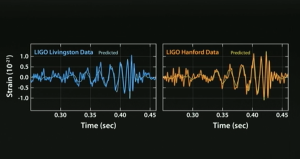 |
|
Signals as seen by the two LIGO detectors |
The event which triggered this gravitational waves is thought to be the merger of two black holes. In terms of the gravitational waves, it is believed to be such a powerful event that it will momentarily outshine the entire known Universe!
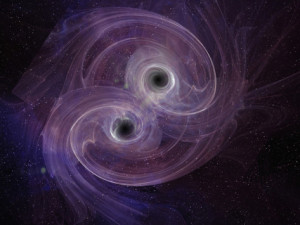 |
|
Artists imagination of merging of two black holes |
Discovery of the gravitational waves opens up new and exciting possibilities for Cosmology and Astrophysics. Up till now our capability to observe the Cosmos was restricted to light (visible light, radio waves, ultraviolet, x-rays etc.) and neutrinos. While we have learned a lot about the Cosmos by studying electromagnetic signals from far reaches of the Cosmos, there are limitation to the amount of knowledge that can be gathered through light alone. On the other hand, neutrinos can be an excellent source of information but their illusive, reserved nature makes them hard to catch and study.
Over the next few decades the detector design of LIGO will continue to improve and collect more information on gravitational waves. Now that we know gravitational waves exists and we have a rudimentary knowledge of their nature, we know how the design of the detector needs to be improved. This will make way for the second generation of gravitational detectors which are more sensitive. Exciting is hardly sufficient a word for what I feel about this discovery. Only time will tell how this discovery will shape our understanding of the great Cosmos!
